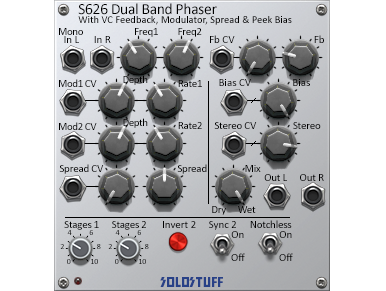Product Description
(This module is included in the System B)
The S626 takes a few steps beyond the typical phaser. A phaser works by introducing a number of notches and peaks (i.e stages) into the audio spectrum and then moving them with an internal LFO to create the well known effect. This is internally usually done by a cascade of all-pass phase shifters and then mixing the output with the input audio. This method is CPU efficient but lacks the ability to extensively control the different aspects of the effect and is prone to unwanted side-effects. The S626 uses a different method that directly introduces the notches and peaks without the use of phase shifters and mixing. This method is slightly more on CPU usage but is much more powerful and doesn’t exhibit any side-effects.
The S626 works in two frequency bands. Each band has it’s own stages*. There are 10 stages per band for a whooping total of 20 stages!! (There is nothing like this out there as far as we know). Freq1 and Freq2 knobs control the middle frequency of each band. Each band has it’s own internal LFO controlled by knobs Rate1 and Rate2. External CV modulator control is also possible using the Mod1 CV and Mod2 CV patch points. Each Depth knob controls the depth for both the internal LFO and external modulator. The internal LFOs can be switched OFF by setting the rates knobs to minimum which will also reset the phase of the LFOs. The Fb (feedback) knob/CV controls how high the peaks will go. The Spread knob/CV controls the distance between a notch/peak and the next notch/peak. The Bias knob/CV controls where each peak is situated relative to it’s neighboring notch. At half bias, the peak will be exactly at the notch which is usually not very useful, interesting results are either above or below half bias. Modulating the bias makes sense too.

A Stereo knob/CV is also provided. This one can make dramatic changes to the sound. This is were all the fun happens, you can get pretty complex effects when set anything bellow 1 o’clock. At full stereo, the two bands are totally separated into the left and right output patch point. In L is normaled to In R**. At minimum stereo (mono), the In R input is totally ignored, the two bands take their input from In L and are fully cascaded together into one signal that is sent through both the left and right outputs. A Mix knob is also available that morphs between the dry and wet signal.
The Sync 2 switch will sync LFO 2 to LFO 1. So Rate1 will be the master rate, and Rate2 will synchronize to Rate1. So at minimum Rate2 is 1/8th of Rate1. And at maximum, Rate2 is 8 times Rate1. If you set Rate2 knob at half, it will be exactly as Rate1.
The Invert 2 button adds half a cycle period to the internal LFO 2 every time it’s pressed. This will flip the movement direction of LFO 2. This is useful if you want band 2 to move in the opposite direction of band 1. Notice that this will not be practical unless the two LFOs are synced or have the same rates because the direction will eventually flip and flip again and again as the LFOs get out of phase and in phase again repeatedly in time.
Finally the notchless switch simply removes all notches from the stages and keeps all the peaks when set to ON. This will give different and a higher resonant effect.
Technical Details
The S626 can be very heavy on CPU when a high number of stages is used. It’s best to try to limit your usage of stages to whats just enough to achieve your desired effect. For example, if your using a large spread, there may be no point of having a large number of stages since most of them would probably either go ultra sonic or sub sonic and only a few would be audible. Use a spectrum analyzer to assist in that manner.
* One stage consists of one notch and one peak.
**If no cable is patched into In R, Then In L is fed to In R


Reviews
There are no reviews yet.